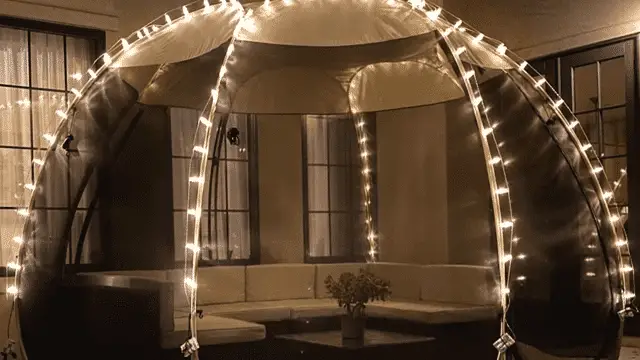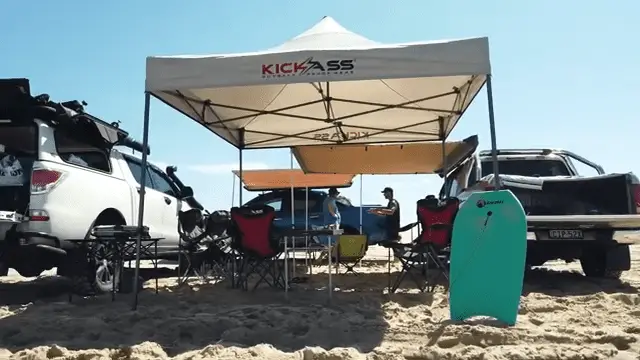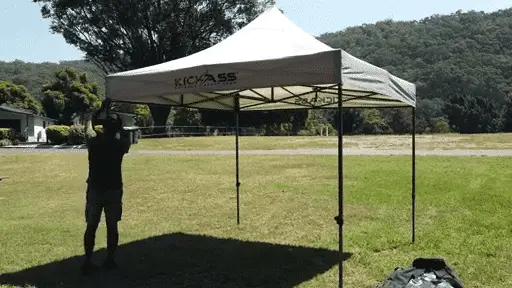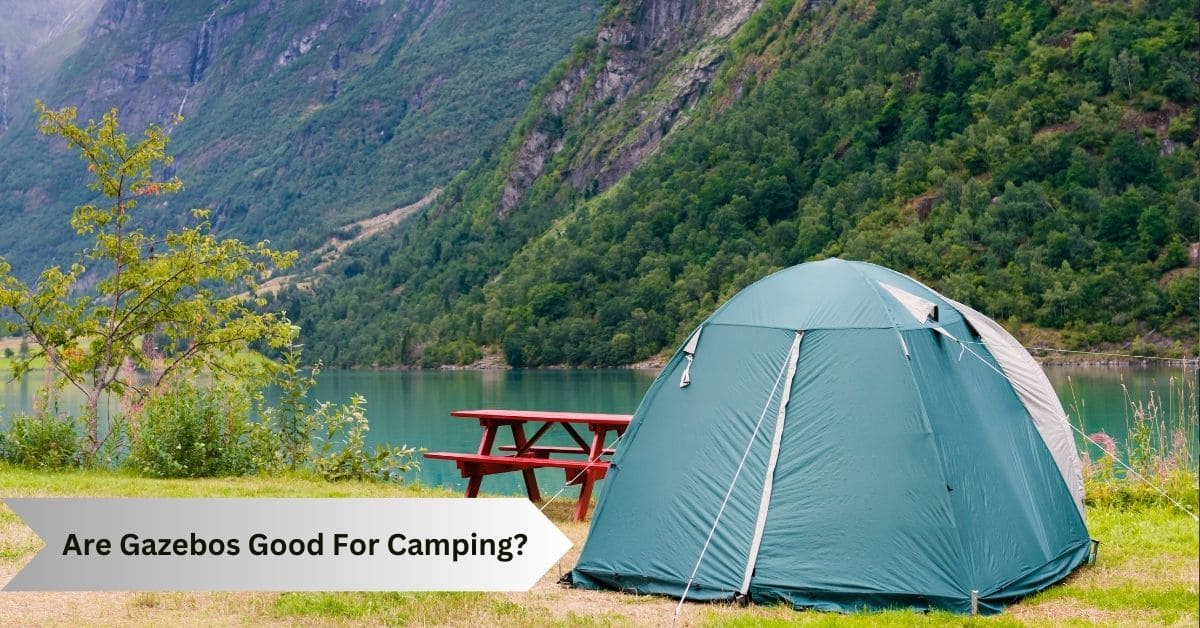Are Gazebos Good For Camping? If you have a yard or patio, adding a gazebo can be really nice. It can be helpful for hosting parties or giving you a shady spot to relax when it’s sunny out. A good quality gazebo should be broad, not attached to anything else, and able to protect you from different kinds of weather.
They can be a really good choice for your campsite, for having a get-together, for staying cool in the summer, and for staying protected in the winter.
If you want to have a good time camping, you must have the right supplies and equipment. If you have a big, hard-to-move, or complex gazebo, it can take a lot of time to set up and take down. This could use up a lot of your vacation time.
Are Gazebos Good For Camping: Gazebos are not heavy like tents and they don’t take up a lot of space when you store them. This makes them a good choice for making your camping area (or garden) bigger without having to carry around heavy stuff.
What Exactly is a Camping Gazebo?
A camping gazebo is a light and easy-to-move shelter that you can set up in parks or campsites. It helps protect you from the weather and insects. The doors and windows of this kind of gazebo have mesh screens made of water-resistant nylon, which keeps bugs out.
Camping gazebos use lightweight aluminum or fiberglass poles that are easy to set up. These gazebos are not permanent structures, which makes them good for camping. They can be made stable by using stakes during mild winds.
If there are winds, you can stake out the corners of your camping gazebo to make it more stable. You can pound lightweight metal spikes into the ground and attach the gazebo’s ropes to them. This makes the gazebo more secure.
If there are very strong winds, the gazebo could still be uprooted. However, if the gazebo is staked out properly, moderate winds won’t be able to push it away.
For camping gazebos, nylon is a good material because it is light, easy to pack, and doesn’t tear easily. Nylon is also water-resistant. Mesh screens are often sewn into the nylon to let air through but keep bugs out.
Camping gazebos can be stored in a nylon bag, which is good for people who like to hike or camp.
Can You Easily Carry a Gazebo to a Campsite?

A gazebo is a great choice for a camping trip because it’s easy to use and move around. In the past, gazebos used to be very heavy and bulky, with thick pipes. But nowadays, gazebos are lightweight, foldable, and easy to carry.
They don’t take up much space and you can adjust them to fit your needs. Plus, they’re simple to set up. All of these things make gazebos a popular choice for camping.
If you’re hiking to your campsite, a gazebo is still a good option. They’re made of lightweight materials, so you can easily carry them in your backpack.
You can set them up quickly once you get to the campsite, and when you fold them up, they don’t take up much space. This means that a gazebo won’t make your backpack too heavy or bulky.
Is a Gazebo a Better Option Than a Regular Tent for Camping?
Whether or not you need a gazebo depends on how you want to spend your camping trip. If you’re just going to stay in your tent or caravan, then a gazebo might not add much to your experience. But if you want to enjoy the outdoors, a gazebo can be really helpful.
A gazebo has advantages over a tent in several ways. For one, it gives you shelter from the weather while still allowing you to enjoy the outdoors. If it’s raining, you can sit in the gazebo and watch the rain while staying dry. You can still enjoy the fresh air and listen to the sounds of nature.
A gazebo with sides can act as a windbreaker and keep you protected from the chilly air as the summer season transitions into fall. You can enjoy your camping trip even if there’s a light rain or breeze by staying inside the gazebo. You don’t have to end your evening early and retreat to your tent or caravan for shelter.
Are Gazebos Good For Camping? Qualities to Look for in a Camping Gazebo
A camping gazebo can provide protection from different weather conditions. However, there are some important things to think about. Let’s Discuss this!
Consider Ease of Set-Up When Choosing a Camping Gazebo

When choosing a camping gazebo, it’s important to consider how easy it is to set up. Accordion assembly is the quickest and easiest method, as the gazebo expands and retracts in one piece.
This type of assembly can be done by one person, which is convenient for camping trips.
Choosing lightweight options for easy carrying
Having the right camping equipment like a gazebo can make your camping trip more enjoyable. It’s important to choose a portable and compact gazebo that’s easy to transport and set up.
Lightweight aluminum is a common material used for camping gazebos and is less likely to be blown away by the wind.
However, the size of the gazebo can affect its weight, so it’s important to consider this when choosing a gazebo. Aluminum gazebos are generally lighter than steel gazebos.
Complete Protection
Many camping gazebos offer UV and rain protection, but if there is no wall, there is no complete protection. That is why full coverage designs offer complete sun protection from all sides.
Right Material
When buying a camping gazebo, it is important to check the material it is made of. Steel or iron rods are durable and resistant to rust and can withstand severe weather. However, if you need to carry your gazebo, lighter aluminum or fiber rods can be helpful.
You should also choose a waterproof roof for all-weather protection and a fabric that offers ventilation, such as a mesh screen. Full coverage with a mesh screen can also prevent the interior from becoming too hot.
Protection from Water and Moisture
Different camping gazebos offer varying levels of water resistance, ranging from none to complete waterproofing. This can affect how well the gazebo performs in different weather conditions and settings.
Choosing a completely waterproof material can provide extra outdoor space and better protection from the weather, making your camping experience more enjoyable.
Designs and Their Features
Camping gazebos have a similar design, but some may have different features, including:
Top Coverage: This type of design provides good ventilation and protection from small insects or bugs, and they are available at a low and affordable price.
Full Coverage: This type of design takes longer to set up because it is larger and less compact, but it provides better protection from the elements.
Partial Coverage: This type of gazebo usually has one or more walls and is a mix of full coverage and top coverage design.
Protection from Mosquitoes and Bugs

Adding a mosquito net to a gazebo is a good idea. The net is usually placed on the sides of the window, which keeps mosquitoes and other bugs out. This helps to keep the inside of the gazebo clean and fresh.
With the mosquito net, you can enjoy your camping without worrying about getting bitten by mosquitoes.
Advantages of Using Gazebos for Camping
Using a gazebo for camping has many advantages. These are as follows:
Protection from the Elements
One of the advantages of using gazebos for camping is that they provide protection from the elements. A gazebo can protect you from the sun, wind, and rain, making your camping experience more comfortable and enjoyable.
It can also provide shade on hot days, which is important for your health and safety. With a gazebo, you can stay outside even when it’s raining or windy, and still, stay dry and protected.
Provides Shade during Hot Weather
Gazebos provide shade during hot weather which can help keep campers cool and comfortable. The shade also helps to protect campers from the harmful effects of the sun’s UV rays.
Additional Space for Storage and Activities
Gazebos provide extra space for storage and activities. You can use them to store your camping gear, set up a picnic table, or use them as a sheltered area for playing games, relaxing, or socializing with your fellow campers. This can make your camping trip more comfortable and enjoyable.
Enhances Camping Experience and Aesthetics

Using a gazebo during camping can enhance the overall camping experience by providing a comfortable and cozy shelter, especially in the evenings or during unfavorable weather conditions.
Additionally, gazebos can add to the aesthetics of the camping site, creating a cozy and inviting atmosphere. With the additional space a gazebo provides, you can engage in various camping activities like cooking, playing games, or relaxing with your friends and family.
Benefits of Using a Gazebo for Camping and Outdoor Parties
A good gazebo is very different from a small and cramped tent. It is spacious, can protect you from different weather conditions, and can stand on its own.
A great gazebo is a necessary part of your camping setup and is perfect for hosting outdoor parties during warm months in your backyard.
Some camping tents and vans have porches or gazebos that are made specifically for that model. However, a freestanding gazebo is more versatile as it can be used in different ways.
For example, it can be used as a shaded porch or a communal space for eating and relaxing. It can also be used as a play area for children when it’s raining outside or as a shaded area for a summer party.
A good gazebo is like a spacious and waterproof tent that offers plenty of room for you and your guests to sit and relax. It should protect you from the elements and keep the inside fresh and breezy even when zipped up.
Unlike heavy tents, gazebos are lightweight and easy to store, making them an ideal addition to your camping gear. We have picked out some of the best freestanding gazebos available, with options for different budgets.
Before we get into our recommendations, we’ve put together a brief guide to help you choose the best gazebo for your needs.
Types of Gazebos for Camping

There are different types of gazebos available for camping. Here are some of the most common types:
Pop-up Gazebos:
Pop-up gazebos are a popular type of gazebo for camping as they are quick and easy to set up. They usually have a collapsible frame that can be easily assembled and disassembled, making them a convenient option for those who don’t want to spend too much time setting up their camping gear.
Pop-up gazebos are also lightweight and compact, making them easy to transport and store. They come in a variety of sizes and styles and can provide shelter from the sun, rain, and wind.
Screened-in Gazebos:
Screened-in gazebos are a type of gazebo that has mesh screens to protect against insects while still allowing air to flow through. These gazebos are great for camping in areas with a lot of bugs or in hot and humid climates.
The screens not only provide protection against mosquitoes and other insects but also offer a certain degree of privacy. Screened-in gazebos are usually easy to set up and take down and can provide a comfortable and relaxing outdoor space.
Heavy-Duty Gazebos:
Heavy-duty gazebos are designed for more extreme weather conditions and are made with sturdy materials to withstand strong winds and heavy rain. These types of gazebos are typically made with steel frames and heavy-duty polyester or PVC-coated fabric.
They are more durable than other types of gazebos, but also tend to be heavier and bulkier to transport and set up. They are a good option for camping in areas with harsh weather conditions or for extended camping trips where you need long-lasting shelter.
Connection with Nature: Can a Gazebo Tent Help?
A gazebo is a great thing to bring along on a camping trip if you want to enjoy the outdoors. It’s perfect if you’re not planning to go hiking, and just want to relax and take in nature.
Sometimes our skin can easily get burnt from too much sun exposure, especially if we’re not used to being outside.
With a gazebo, you can sit outside your tent and still be protected from the sun. It also provides shelter from strong winds and rain, which is useful if you’re camping in bad weather.
With a gazebo, you can set it up almost anywhere you want. You can choose a nice spot away from your tent, near some trees or a stream. Imagine sitting in a private space, with a roof over your head, listening to the sound of the water while you read your favorite book!
If it rains heavily, you can stay dry inside the gazebo instead of being stuck inside your tent. This way, you can still enjoy the weather without getting wet.
Choosing the Right Gazebo for Your Camping Needs

It’s important to pick the right kind of gazebo depending on the weather. If it’s a sunny day, choose a gazebo that is open on the sides so that you can enjoy the breeze without getting too much sun.
But if it’s a rainy day, it’s best to choose a gazebo with side awnings that can protect you from the rain. The side awnings can also keep you safe from strong winds.
When choosing a gazebo, it’s important to consider the size. You don’t want it to be too big or too small for your camping party.
Think about how many adults and children will be using it and what you’ll be using it for. You can find a gazebo that fits your needs.
Also, check the material that the gazebo is made of before buying it. Some materials can catch fire easily, which is dangerous while camping.
It’s important to make sure the supports are made of safe materials too. Some use PVC pipes while others use light metals like aluminum. You can choose the one that works best for you.
Building Your Own Gazebo
To build a gazebo, you need some specific tools and materials to make sure it stands up properly. You’ll need a hammer, nails, a screwdriver, and a saw. You’ll also need wood that’s cut into 24-inch pieces.
If you’re in an area with a lot of moisture, it’s best to use pressure-treated lumber because it resists rotting and decay.
To build a gazebo for camping, it’s best to find a good spot that’s flat and shady. You should also try to set it up before you arrive at the campsite so it doesn’t blow away in strong winds.
When choosing a gazebo, it’s important to think about how many people will be using it. Gazebos come in different sizes and shapes, so you need to decide which one is best for you.
If you have a big family, you should get a bigger gazebo. But if you’re on a tight budget, you can get a smaller one that’s easier to carry around and still provides shade and protection.
Removing Your Gazebo: Step-by-Step Instructions
Here are the steps to take when taking down your gazebo after your vacation:
- Remove the framework of the gazebo by taking out all the screws that hold each frame component. You can use a drill or a screwdriver.
- After the framework is taken down, remove the gazebo canopy.
- Disassemble the supporting poles by removing the screws that keep them in place. Sometimes, you may only need to remove one component without disconnecting anything else.
- Remove the screws and nails that hold the walls in place.
- Remove any sheets covering the area.
- Use a hand-screw instead of power tools to avoid damaging the wood.
- Be careful not to harm the wood while taking apart the gazebo.
Factors to Consider When Choosing a Gazebo for Camping
Here are the factors to consider when choosing a gazebo for camping. We discuss these factors below!
Size and Weight:
The size and weight of a gazebo are important things to consider when choosing one for camping. You’ll want to make sure that the gazebo is large enough to accommodate your group and the activities you have planned, but not so big that it’s difficult to transport.
The weight of the gazebo is also important because you’ll need to be able to carry it to your camping spot. A heavier gazebo may be sturdier but more difficult to carry, while a lighter one may be easier to transport but less durable.
Durability and Weather Resistance:
Durability and weather resistance are important factors to consider when choosing a gazebo for camping. You’ll want to make sure that the gazebo is made of sturdy materials that can withstand the rigors of outdoor use.
It’s also important to choose a gazebo that is weather-resistant, so it can protect you from rain, wind, and sun. Look for gazebos made from materials like aluminum or steel frames, and canopies made from UV-resistant materials that are also waterproof.
A durable and weather-resistant gazebo can provide a comfortable and safe outdoor space for your camping trip.
Portability and Storage:

Portability and storage are important factors to consider when choosing a gazebo for camping. You’ll want to choose a gazebo that is easy to transport and store when not in use.
A gazebo that can be easily folded and packed into a carrying bag or case is ideal for camping trips. Look for gazebos that come with their own carrying bag or case, so you can easily transport them to and from your camping site.
Additionally, consider the storage space you have available at home for your gazebo. A compact and easy-to-store gazebo can be a convenient option for those with limited storage space.
Price Range:
The price range is an important factor to consider when choosing a gazebo for camping.
You’ll want to find a gazebo that fits your budget while still meeting your needs. Keep in mind that the price of a gazebo can vary depending on its size, materials, and features. A larger and more durable gazebo will likely be more expensive than a smaller and less durable one.
However, investing in a high-quality gazebo that will last for many camping trips may be worth the higher cost in the long run. Consider your budget and what features are most important to you when selecting a gazebo for camping.
FAQs:
Q:1 Can you Sleep in a Gazebo Tent?
If you have a cozy sleeping bag or mattress to lay inside, then you can definitely sleep in a gazebo. Even though gazebos are designed for people to sit, relax, and enjoy the outdoor environment, they can also be used for sleeping.
Q:2 What are Gazebos good for?
A gazebo is a structure that stands on its own with an open design and a roof. People usually place them in their backyard or patio area.
Patio gazebos are an excellent way to create more space in your backyard. You can use them to relax with your family, get some shade from the sun, or host guests.
Q:3 Are Gazebos Worth it?
Gazebos are a great investment. There are permanent gazebos that are very attractive and add value to your garden. However, they can be costly, ranging from $3,500 to almost $10,000, and if you add features like a cupola, tiered roof, or screening, the price can increase even more.
Q:4 Can you get Struck by Lightning under a Gazebo?
During thunderstorms, it is not safe to stand under a tree or in a gazebo as they do not provide full protection. Only fully enclosed structures with wiring and plumbing can protect you.
Wearing rubber boots will not save you from lightning strikes. If you are caught outside during a thunderstorm, it is best to stay away from tall structures to avoid any risk.
Q:5 What is better than a Gazebo?
Pergolas have a simpler and more stylish design than gazebos. They usually have a roof that can be fully opened or closed, but some only offer partial shade with open spaces between the roof beams.
Conclusion:
In conclusion, gazebos can be a great addition to your camping equipment as they provide shade, shelter from light rain, and a comfortable place to relax.
When choosing a gazebo for camping, it’s important to consider factors such as size and weight, durability and weather resistance, portability and storage, and price range.
With proper setup and maintenance, a gazebo can be a valuable asset on your camping trips, adding convenience and comfort to your outdoor experience.
However, it’s important to remember that gazebos are not designed to withstand severe weather conditions such as strong winds or thunderstorms, so it’s always important to prioritize safety and follow precautions when using a gazebo while camping.
We hope you will be aware that Gazebos are good for camping, after reading this comprehensive guide. If you have any questions, feel free to comment below!


